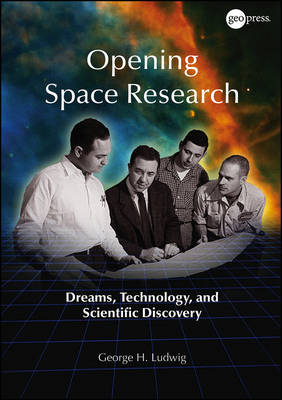
Opening Space Research
American Geophysical Union (Verlag)
978-0-87590-733-8 (ISBN)
- Titel ist leider vergriffen;
keine Neuauflage - Artikel merken
Published by the American Geophysical Union as part of the Special Publications Series.
Opening Space Research: Dreams, Technology, and Scientific Discovery
is George Ludwig's account of the early development of space-based electromagnetic physics, with a focus on the first U.S. space launches and the discovery of the Van Allen radiation belts. Narrated by the person who developed many of the instruments for the early Explorer spacecraft during the 1950s and participated directly in the scientific research, it draws heavily upon the author's voluminous collection of laboratory notes and other papers, upon the Van Allen archive, and upon a wide array of other sources. This book presents very detailed discussions of historic events in a highly readable (semitechnical), first-person form. More than that, though, Opening Space Research brings to the forefront the entire team of scientists who made these accomplishments possible, providing an extensive index of names to enhance and complete the historical record. Authoritative and unique, this book will be of interest to space scientists, science historians, and anyone interested in space history and the first U.S. space launches.
George H. Ludwig was the former chief research scientist for the National Aeronautics and Space Administration's satellite systems and director of operations for the National Oceanic and Atmospheric Administration.
Foreword ix
Prologue xi
Introduction 1
Special acknowledgments 3
Chapter 1: Setting the Stage at the University of Iowa 5
Initiating the Iowa cosmic ray program 7
Inventing the rockoon 10
Chapter 2: The Early Years 21
Entering opportunity’s door 21
The summer 1953 rockoon expedition 23
McDonald's andWebber’s balloon programs, 1953–1955 33
The summer 1954 third rockoon expedition 36
A great personal adventure, summer 1955 37
Discovery of the auroral soft radiation 54
Anderson's Canadian balloon flights in early 1956 57
Iowa City balloon flights in March 1956 59
Chapter 3: The International Geophysical Year 67
IGY inception and early planning 67
Adding rockets to the program 70
Artificial Earth satellites 70
A retrospective view of the IGY 84
Chapter 4: The IGY Program at Iowa 89
Ground-launched rockets 89
Projects sometimes failed 94
Large balloons 96
Rockoons 102
Chapter 5: The Vanguard Cosmic Ray Instrument 125
Van Allen’s cosmic ray experiment
proposals 126
Major challenges 127
Evolution of the instrument design 130
Assembling and testing the instrument 137
Final work on the Vanguard instrument 151
Additional notes on the data recorder 152
Chapter 6: Sputnik! 159
Early indications of Soviet intentions 159
Scientists gather to review IGY progress 163
A memorable cocktail party: The announcement 166
Closing the conference 170
Continuing reactions 173
Chapter 7: The U.S. Satellite Competition 177
Competing launch vehicle proposals 177
The Stewart Committee and the Vanguard decision 186
Keeping the Orbiter dream alive 193
Chapter 8: Go! Jupiter C, Juno, and Deal I 213
Obtaining the approvals 214
Preparations at Huntsville and Pasadena 216
A call from the Jet Propulsion Laboratory 217
A hurried move to California 231
Building the Deal I satellite 234
Instrument calibration 235
The corona discharge problem, again 238
Environmental testing 238
Chapter 9: The Birth of Explorer I 245
The first countdown attempts 245
The Deal I launch: Explorer I in orbit! 247
Public jubilation 257
Returning from the Cape 258
Chapter 10: Deal II and Explorers II and III 263
Building the Deal II instruments 263
To Cape Canaveral for the Deal II launch 269
A heartbreaking failed launch attempt 272
The crash effort for a second try 276
The Vanguard I launch 280
A successful Explorer III launch! 280
Chapter 11: Operations and Data Handling 287
Explorer I operation 287
Explorer I data acquisition 291
Explorer III operation 293
Explorer III data acquisition 295
Data flow 297
The ground network 298
Data tape logistics 305
Making the data intelligible 309
Reading and tabulating the information 313
Chapter 12: Discovery of the Trapped Radiation 319
Iowa's cosmic ray experiment 321
Early hints of the high-intensity radiation 324
Examining the Explorer I data 325
From perplexity to understanding with Explorer III 330
My hurried move back to Iowa City 336
The announcement 339
The Soviets missed the discovery 347
Chapter 13: Argus and Explorers IV and V 359
Nuclear weaponry and the cold war 359
The Argus effect and project 361
NOTSNIK 364
The Iowa cosmic ray group and Argus 365
Explorer IV and V preparation and launch 367
Explorer IV operation 375
Early unclassified Explorer IV results 376
Argus results 380
Chapter 14: Extending the Toehold in Space 395
Completing the first generation 395
Second-generation spacecraft 406
An early scorecard 417
Chapter 15: Pioneering in Campus Space Research 421
The Cosmic Ray Laboratory 421
Establishing the university’s role in space research 425
Training ground for Space scientists 426
Chapter 16: Some Personal Reflections 429
Family life 429
The university scene 431
Collegial interactions 434
Public exposure 438
Physics or engineering 438
The value of an outstanding mentor 440
The spirit of the times 441
Epilogue 445
Acronyms and Abbreviations 449
Selected Bibliography 453
Name Index 457
Subject Index 465
| Reihe/Serie | Special Publications |
|---|---|
| Sprache | englisch |
| Maße | 179 x 255 mm |
| Gewicht | 1188 g |
| Themenwelt | Literatur ► Biografien / Erfahrungsberichte |
| Naturwissenschaften ► Geowissenschaften ► Geologie | |
| Naturwissenschaften ► Geowissenschaften ► Geophysik | |
| Naturwissenschaften ► Physik / Astronomie | |
| ISBN-10 | 0-87590-733-4 / 0875907334 |
| ISBN-13 | 978-0-87590-733-8 / 9780875907338 |
| Zustand | Neuware |
| Haben Sie eine Frage zum Produkt? |
aus dem Bereich


